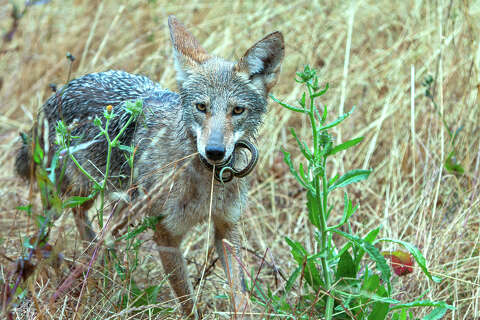California
Related: About this forumNew study reveals what urban coyotes are really eating in San Francisco
LOCAL
New study reveals what urban coyotes are really eating in San Francisco

A coyote moves through tall grass with a snake in its jaws.
Photo by Janet Kessler
By Amanda Bartlett
March 10, 2024
On a foggy morning just after 7 a.m., Tali Caspi sat behind the wheel of a golf cart and drove across the manicured hills of the San Francisco Golf Club, searching for evidence. … Dew clung to the greenery, and save for a couple of red-tailed hawks soaring through the sky, there wasn’t a soul in sight. Armed with Google Maps and a fanny pack, the UC Davis Ph.D. student zoomed along the fairway until she found a thicket of bushes. She put the cart in park, stepped out and knelt down in the wet grass, scrutinizing the lumpy brown object that lay before her. It was exactly what she had been looking for: coyote poop.
She jotted down the information in her field notebook: where she had found the scat and what time of day it was. Then, she slid on a pair of white rubber gloves and retrieved a little tube filled with ethanol from her fanny pack, taking off a piece of the scat and shoving it into the tube with a wooden applicator stick to help preserve the DNA. She labeled and sealed it, and set off to find more.
Caspi’s notes from that day spare no detail. Some of the found samples were “full of cherry plum pits and berries” while others were “twisted in shape and full of hair.” One had just been deposited by a coyote she saw darting across the course and was mottled with tiny bones. There were traces of orange peel and aluminum foil, and one in particular was overflowing with peanuts.

Tali Caspi, lower left, takes samples of coyote scat in San Francisco with Christine Wilkinson, a conservation biologist and carnivore ecologist at the University of California, Berkeley and the California Academy of Sciences.
Gayle Laird © California Academy of Sciences
Caspi has spent two years of her mornings like this, traversing over 621 miles throughout San Francisco — crisscrossing popular neighborhoods, scouring cemeteries and soccer fields, even breaking her foot during one hike up Bernal Hill — on her quest to find out what urban coyotes living in the city are actually eating. … “I feel like there’s not a park, not a trail that I haven’t been on,” Caspi, who conducts her research through UC Davis' mammalian ecology and conservation unit, told SFGATE. “I have them all memorized like the back of my hand at this point. And I can tell you, truly every green space that you can think of in the city has coyotes. San Francisco is totally saturated.”
{snip}
NJCher
(37,868 posts)For an advanced degree.
The hair thing. Yeah, that would end it for me.
Auggie
(31,798 posts)It's not the only source of coyote food according to the article, but it's significant.